
Dimdima
Online Children's Magazine from India

Dimdima
Online Children's Magazine from India
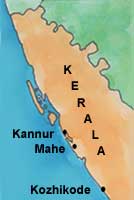
As we move southwards down the west coast of India, Karnataka gives way to the almost 550 km long, narrow, green coastal strip of Kerala - the land of Keras or coconut palms. It was originally called 'Cheralam', meaning the land added by the recession of the sea. Parasurama ia believed to have created it by flinging his axe into the sea. However, according to geologists, the land of Kerala was formed as a result of volcanic activity, much after the Indian landmass was formed.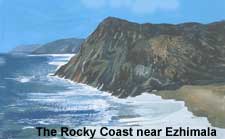
Traders from Egypt, Arabia, Greece, Assyria and Rome, long before the Christian era, were attracted to the Malabar coast, mainly for the pepper which grew in abundance there. Kannur, Thalassery, Kozhikode, Panthalayani, Beypore and Quilandi were some of the flourishing ports of North Malabar. Ezhimala, in the Kannur district in north Kerala, is a 216 m high hill that juts 250 m into the sea. The Indian circus industry has its beginnings in Kerala. Almost all the leading circus troupes of the country are run by Malayalees from the Kannur- Thalassery area. The first circus training institute was founded at Thalassery in 1901 by Kunhiraman, who was a great master of the martial art of Kerala- Kalarippayat.
The Indian circus industry has its beginnings in Kerala. Almost all the leading circus troupes of the country are run by Malayalees from the Kannur- Thalassery area. The first circus training institute was founded at Thalassery in 1901 by Kunhiraman, who was a great master of the martial art of Kerala- Kalarippayat.
South of Thalassery is Mahe, a picturesque coastal town which is part of the Union Territory of Pondicherry. It was once called Mayyazhi but was renamed Mahe in honour of Captain Bertrand Francois Mahe de Labourdonnais, who seized the town for the French. When the French left India they offered French citizenship to all those who were living in their former possessions. So there are many French citizens of Indian origin in the Union Territory. The French parliament has a member to represent these overseas citizens of France.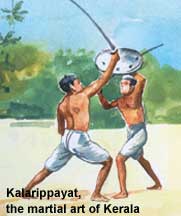
Vadakkekara or Badagara, south of Mahe is a centre of trade and commerce. Pepper and coconut products are the main items of trade.
Badagara is also the birthplace of Taccholi Othenan, the great folk hero of North Malabar. The daring exploits of this warrior, who died at the young age of 32 are immortalised in 'Vadakkan Pattukal', the ballads of North Malabar. Ceremonies in Othenan's honour are conducted every year at a temple near Badagara.
Moving further south we come to Pandalayani, which is a place of considerable historical importance. There is a 7th century mosque here which is almost identical to the one at Mecca. In days gone by, Arab vessels sailing past would stop to salute this mosque. On the seashore, close to the mosque is a footprint which the local people believe was made by Adam when he stepped on Indian soil en route to Lanka. Further south is Kozhikode, once known as Calicut. In the 9th century A.D., Cheraman Perumal, the last king of Malabar, left for Mecca after distributing his lands among the various chieftains of his kingdom. To one of them, the Zamorin, he gave all the land over which a cock crowing from the Tali temple could be heard..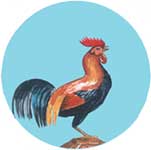
The land was called Kozhikode, the land where the cock crows.
'Zamorin' was a hereditary title. It was a corruption of the word 'Samuthiri' which means, 'Lord of the Seas'.
The Zamorins with the help of their admirals, known as the Kunjali Marakkars made Kozhikode a powerful maritime principality.
The Chinese traded with Kozhikode early in the 15th century, exchanging gold, silver, copper and silk for pepper,cinnamon, ginger and cotton cloth. 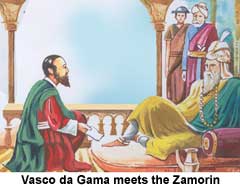
It was near Kozhikode that Vasco da Gama landed in May 1498. It was an epochmaking event in history. Vasco da Gama's discovery of the sea route to India opened up the country and the rest of Asia to the West and changed the destinies of many nations.
The Zamorin received the Portuguese courteously but he was not impressed with the presents they had brought - hats, striped cloth, strings of coral beads and washbasins. The Portuguese asked for trading facilities at Calicut. The Zamorin was evasive at first but later gave them permission to build a fort at Calicut.
The English first appeared in Calicut in 1615 but it became a possession of the English East India Company only in 1792, following a treaty with Tipu Sultan.
Today Kozhikode is a centre of the timber industry. One of the largest timber yards in the world is Situated in its suburb, Kallai.
Nine kilometres to the south of Kozhikode is the coastal town of Beypore. Tipu Sultan called it 'Sultan Pattanam' and made it his capital of Malabar. The town has a boat-buiiding yard and trades in coconut products.
Last updated on :3/15/2005
Dimdima is the Sanskrit word for ‘drumbeat’. In olden days, victory in battle was heralded by the beat of drums or any important news to be conveyed to the people used to be accompanied with drumbeats.
Bharatiya Vidya Bhavan
K. M Munshi Marg,
Chowpatty, Mumbai - 400 007
email : editor@dimdima.com
Bharatiya Vidya Bhavan
505, Sane Guruji Marg,
Tardeo, Mumbai - 400 034
email : promo@dimdima.com
Dimdima.com, the Children's Website of Bharatiya Vidya Bhavan launched in 2000 and came out with a Printed version of Dimdima Magazine in 2004. At present the Printed Version have more than 35,000 subscribers from India and Abroad.